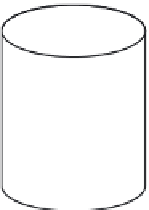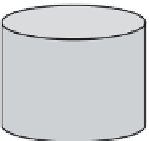Geoscience Reference
In-Depth Information
Solvent
Solute
FIGURE 14.2
Solution with two components: solvent and solute. (From Spellman, F.R.,
Handbook of Water
and Wastewater Treatment Plant Operations
, 3rd ed., Lewis Publishers, Boca Raton, FL, 2013.)
usually water is colorless, the light necessary for photosynthesis can travel to considerable depths;
however, a solution may be colored when the solute remains uniformly distributed throughout the
solution and does not settle with time. When molecules dissolve in water, the atoms making up the
molecules come apart, or dissociate, in the water. This dissociation in water is called
ionization
.
When the atoms in the molecules come apart, they do so as charged atoms (both negatively and
positively charged) which are called
ions
. The positively charged ions are called
cations
and the
negatively charged ions are called
anions
. A good example of the ionization process is when cal-
cium carbonate ionizes:
↔
+
2+
CO
2-
CaCO
Ca
3
Calcium
carbonate
Calciumion
(catio
Carbonate ion
(anion)
n)
Another good example is the ionization that occurs when table salt (sodium chloride) dissolves
in water:
↔
+
+
_
NaCl
Na
Cl
Sodium
chloride
Sodium ion
(cation)
Chloride ion
(anion)
Some of the common ions found in water and their symbols are provided below:
Hydrogen H
+
Sodium Na
+
Potassium K
+
Chloride Cl
-
Bromide Br
-
Iodide I
-
Bicarbonate HCO
3-
Solutions serve as a vehicle to (1) allow chemical species to come into close proximity so that
they can react; (2) provide a uniform matrix for solid materials, such as paints, inks, and other coat-
ings so they can be applied to surfaces; and (3) dissolve oil and grease so they can be rinsed away.
Water dissolves polar substances better than nonpolar substances. Polar substances (mineral acids,
bases, and salts) are easily dissolved in water. Nonpolar substances (oils, fats, and many organic
compounds) do not dissolve as easily in water.



































Search WWH ::

Custom Search